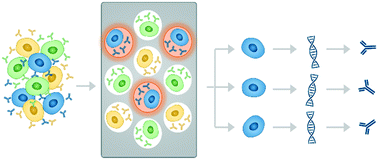Miniaturized single-cell technologies for monoclonal antibody discovery†
Abstract
Antibodies (Abs) are among the most important class of biologicals, showcasing a high therapeutic and diagnostic value. In the global therapeutic Ab market, fully-human monoclonal Abs (FH-mAbs) are flourishing thanks to their low immunogenicity and high specificity. The rapidly emerging field of single-cell technologies has paved the way to efficiently discover mAbs by facilitating a fast screening of the antigen (Ag)-specificity and functionality of Abs expressed by B cells. This review summarizes the principles and challenges of the four key concepts to discover mAbs using these technologies, being confinement of single cells using either droplet microfluidics or microstructure arrays, identification of the cells of interest, retrieval of those cells and single-cell sequence determination required for mAb production. This review reveals the enormous potential for mix-and-matching of the above-mentioned strategies, which is illustrated by the plethora of established, highly integrated devices. Lastly, an outlook is given on the many opportunities and challenges that still lie ahead to fully exploit miniaturized single-cell technologies for mAb discovery.

- This article is part of the themed collection: Lab on a Chip HOT Articles 2021


 Please wait while we load your content...
Please wait while we load your content...